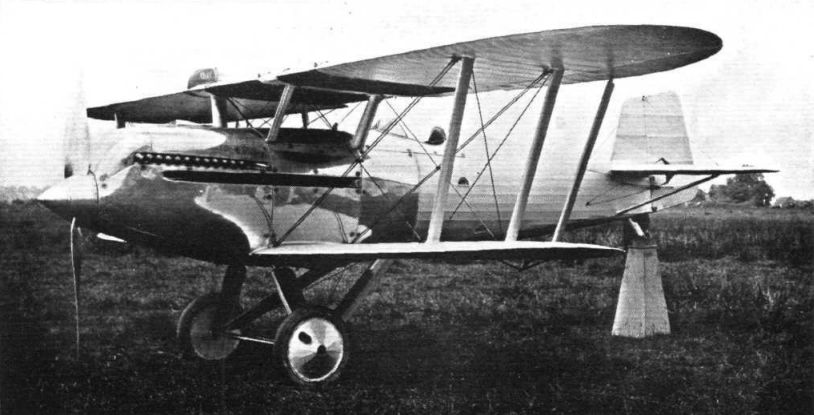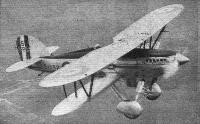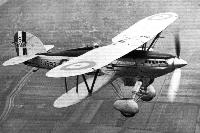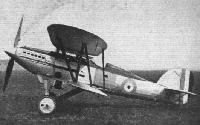
Firefly
Одноместный истребитель, цельнометаллический биплан смешанной конструкции с открытой кабиной и неубирающимся шасси. Спроектирован в КБ фирмы "Фэйри авиэйшн компани" под руководством М.Лобеля. Опытный образец истребителя "Файрфлай" II впервые поднялся в воздух 5 февраля 1929 г. Проиграв конкурс истребителю Хаукер "Фьюри", на вооружение английских ВВС принят не был, но его цельнометаллический вариант IIM с 1931 г. строился на экспорт по заказу Бельгии на заводе "Фэйри" в Хейсе, а позднее - дочерней фирмой "Авионс Фэйри" в Госселье (Бельгия). Всего изготовлено 88 экз. Самолет состоял на вооружении в Бельгии с 1932 г. Мотор "Кестрел" IIS, вооружение 2x7,69. Истребители "Файрфлай" IIМ применялись бельгийскими ВВС при отражении нападения немцев на Бельгию в мае 1940 г. После разгрома бельгийской армии уцелевшие самолеты эвакуированы во Францию и Алжир, а затем выданы правительством Виши немцам. Дальнейшая их судьба неизвестна.
"Файрфлай" IIM||
Размах:||9,6 м
Длина:||7,52 м
Моторы, количество х мощность:||1x480 л.с.
Взлетная масса, максимальная:||1490 кг
Максимальная скорость:||359 км/ч
Описание:
- Firefly
- Fairey Firefly (биплан)
- Flight, June 1929
BRITISH AIRCRAFT AT OLYMPIA - Flight, July 1930
THE FAIREY "FIREFLY IIM" - Flight, November 1932
British Aircraft at the Paris Aero Show - Flight, November 1932
British Aircraft
Фотографии
-
Flight 1926-06 / Flight
FOR THE R.A.F. DISPLAY AT HENDON: This three-quarter front view of the Fairey "Firefly" shows this machine to be the logical development, in single-seater form, of the Fairey "Fox." The engine is a Fairey "Felix." This machine is probably the fastest single-seater fighter in this country at the present time.
-
Flight 1926-07 / Flight
The Fairey "Firefly" (Fairey "Felix") With its fuselage of streamline form and small cross-sectional area, its wing radiators and its very simple undercarriage, the Fairey "Firefly" is a single-seater fighter of quite exceptionally "clean" lines, and will be sure to create an excellent impression at Hendon where, like the other three machines of this class, it will be seen in public for the first time. The small overall width of the engine and the absence of a nose radiator enables the front portion of the fuselage to be practically free of "bulges," thus saving head resistance, while the "lines" of the nose are carried to a point by •a small spinner over the boss of the Fairey-Reed Duralumin pro-•peller.--
-
Flight 1929-07 / Flight
FAIREY S.S. FIGHTER SHIPPLANE (Rolls-Royce "F")
-
Flight 1929-07 / Flight
FAIREY "FIREFLY II" (Rolls-Royce "F").
-
Мировая Авиация 123
Самолет Firefly II имел выдвижной радиатор, новое хвостовое оперение и отличался весьма изящными и аэродинамически чистыми очертаниями.
-
Flight 1930-07 / Flight
THE FAIREY "FIREFLY": These three views give a very good idea of the clean lines of this interceptor fighter. The engine is a Rolls-Royce supercharged "F" type.
-
Aeroplane Monthly 1988-02 / K.Desmond - Richard Fairey 1887-1956 (2)
The sleek Fairey Firefly IIM biplane of 1930 was of all-metal construction under its fabric covering, and was powered by the Rolls-Royce F.XIS liquid-cooled V12 engine, later redesignated Kestrel IIS.
-
Flight 1932-09 / Flight
Maj. le Baron de Woelmont, Chief of the Staff to Gen. Gillieaux, in his Fairey "Firefly" (Rolls-Royce "Kestrel").
-
Flight 1930-06 / Flight
THE FAIREY "FIREFLY": An Interceptor Fighter, of all-metal construction and fitted with Rolls-Royce "F" type supercharged engine. The very clean lines show a strong resemblance to other Fairey machines.
-
Flight 1931-07 / Flight
IGNORING THE WEATHER: Mr. Staniland's exhibition on the Fairey "Firefly" in the weather which Heston suffered on Saturday was one of the most imposing ever seen. He is here seen just starting a climbing roll.
-
Flight 1930-07 / Flight
"ON HIS TAIL": A Fairey "Firefly," piloted by Flight-Lieutenant Staniland, in hot pursuit of another Fairey machine, piloted by Flying Officer McMullin, the tail of which can be seen in the foreground. Note that the two machines are circling and banking.
-
Flight 1931-04 / Flight
"FIERY" PERFORMANCE: Mr. Staniland demonstrating, in no uncertain manner, the terrific performance of the Fairey Firefly II at Hanworth before the Japanese Prince and Princess Takamatsu.
-
Flight 1932-09 / Flight
THE BROAD ARROW: Six "Fireflies" of a Belgian squadron from Nivelles.
-
Flight 1932-09 / Flight
AN ESCADRILLE FROM NIVELLES: Good formation flying by a Belgian squadron in "Fireflies."
-
Моделист-Конструктор Истребители Второй мировой войны
Экземпляр истребителя "Файрфлай" IIM на аэродроме НИИ ВВС (СССР)
-
Flight 1934-11 / Flight
The "Firefly," single-seater fighter (Rolls-Royce "Kestrel")
-
Air Pictorial 1977-10 / P.Bish, A.Clancy - Belgian Fairey Tale
The start of it all. Adoption of the Fairey Firefly II by the Belgian Air Force led to the creation of Avions Fairey at Gosselies in 1931 to build the type under licence
-
Flight 1932-01 / Flight
THE "FIREFLY" (ROLLS-ROYCE "KESTREL" ENGINE): One of the machines of which considerable numbers have been ordered by the Belgian Government.
-
Jane's All the World Aircraft 1980 / Encyclopedia of Aviation - Aircraft A-Z - v2
Avions Fairey Firefly IIM.
-
Flight 1939-05 / Flight
The Fairey Firefly, flown by Flt. Lt. C. S.Staniland
-
Flight 1934-08 / Flight
Регистрационный номер: S1592 [6] A SINGLE-SEATER FIGHTER: The Fairey "Firefly" (Rolls-Royce "Kestrel").
-
Flight 1932-07 / Flight
Регистрационный номер: S1592 [6] THE FLEET FIGHTER: The Fairey "Firefly III M" (Rolls-Royce "Kestrel") has been designed as a single-seater fighter for work with the Fleet Air Arm. On this occasion it was being piloted by Mr. Staniland. Fairey's Chief test pilot.
-
Flight 1931-07 / Flight
THE first batch of "Firefly" interceptors (Rolls-Royce "Kestrel" engines) for the Belgian Air Force has now been completed at the Fairey works at Hayes, and are going through their acceptance tests in the presence of Belgian representatives. The photographs show a line of "Fireflies" and two views of a machine in flight, piloted by Mr. Staniland.
-
Flight 1932-09 / Flight
"FIREFLIES" AT NIVELLES: Other squadrons equipped with the same type are stationed at Schaffen.
-
Flight 1932-11 / Flight
FAIREY "FIREFLIES" IN BELGIUM: A line-up of the machines at Nivelles.
-
АвиаМастер 2003-04 / М.Жирохов - Они сражались за Фландрию. Бельгийские ВВС во второй мировой войне /Из истории воздушных войн/
"Файрфлаи" из эскадрильи "Кокот бланш" в довоенной окраске на аэродроме Нивеллес, снимок 1937 года. Позднее эта эскадрилья была перевооружена на "Фиаты".
-
Flight 1930-11 / Flight
Fairey Firefly III M single-seater ship's fighter.
-
Flight 1935-04 / Flight
AN ELOQUENT ARRAY. A concentration of Fairey "Foxes" and "Fireflies" with Rolls-Royce "Kestrel IIS" engines at Everes Aerodrome, Belgium. The King of the Belgians has flown in one of the "Foxes."
Другие самолёты на фотографии: Fairey Fox - Великобритания - 1925
-
Flight 1932-06 / Flight
Регистрационный номер: S1592 [6] SOME OF THE PERFORMERS AT HANWORTH: A large variety of aircraft types was demonstrated, ranging from the Comper "Swift" (Pobjoy) to the Hawker "Hart" (Kestrel) and Fairey "Firefly III" (Kestrel).
Другие самолёты на фотографии: Comper Swift / CLA.7 - Великобритания - 1930Hawker Hart - Великобритания - 1928
-
Flight 1932-09 / Flight
"FIREFLY" PILOTS AT NIVELLES: Standing (left to right), Sergent Pieret, Ier Sergent Doppagne, Adjudant Sauveniere, Capitaine Duthoit, Major Baron de Woelmont, Capitaine Norbert Leboutte, Caporal Richard, Ier Sergent Tahon, Ier Sergent Vincent. Sitting (left to right), Adjudant De Coninck, Ier Sergent Dubois, Sergent Genin, Sergent Vandelanotte, Sergent Desmyttere.
-
Flight 1932-09 / Flight
MEN, WOMEN, AND THE MACHINE: The picture on the left shows "Fireflies" receiving finishing touches in the erecting shop at the Fairey works at Gosselies. On the right is a group of the staff at Gosselies.
-
Flight 1932-11 / Flight
THE FAIREY MACHINES: In this view the wings of the "Fox" rather hide the "Firefly," but actually on the stand both machines are readily viewed, which, needless to say, means admired.
Другие самолёты на фотографии: Fairey Fox - Великобритания - 1925
-
Aeroplane Monthly 1983-03 / P.Capon - Capon's Corner
Регистрационный номер: S1592 [6] Fairey Firefly IIIM prototype S1592 at Calshot on August 9, 1931. This Fleet Air Arm fighter was powered by a 480 h.p. Rolls-Royce Kestrel IIS engine.
-
Flight 1931-09 / Flight
Регистрационный номер: S1592 [6] SCHNEIDER RECONNAISSANCE: A Fairey "Firefly" (Rolls-Royce "Kestrel") used for testing conditions. It also gave a demonstration of aerobatics on the day of the Contest.
-
Flight 1933-07 / Flight Advertisements
THE FAIREY "FIREFLY" MK.II. ... the premier single-seater fighter in the world to-day, unsurpassed in performance and equally remarkable for its extreme and ready manoeuvrability
- Фотографии





































